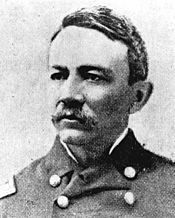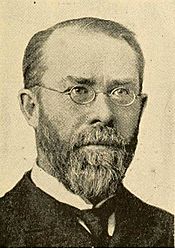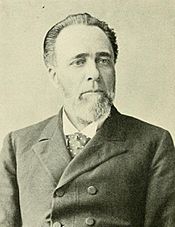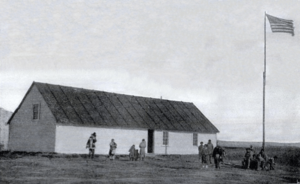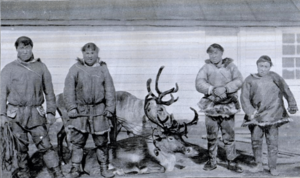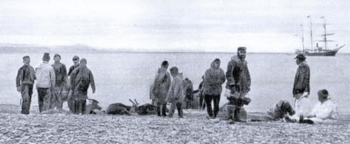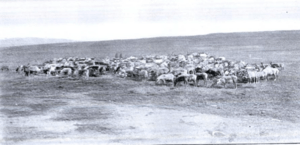Teller Reindeer Station facts for kids
The Teller Reindeer Station was a special place near Teller, Alaska in the U.S. state of Alaska. It was set up to help Native Alaskans get enough food. The idea was to bring reindeer from Siberia to Alaska. This plan was first suggested by Captain Michael A. Healy of the United States Revenue Cutter Service. The station officially started in 1892. It was founded by Sheldon Jackson, who was in charge of education in Alaska and also a Presbyterian minister. He named it after Henry M. Teller. The U.S. Government's program to help with reindeer, called the Alaska Reindeer Service, ended in the early 1900s.
Contents
How the Station Started
On June 29, 1892, Sheldon Jackson looked for the best spot to build the reindeer station. He needed a place close to Asia, with a good harbor, and plenty of grass and water for the reindeer. He found the perfect spot near Grantley Harbor, where whaling ships often stopped for water.
Jackson chose this place for the station. On the same day, he set up two tents. Supplies for the station were brought off the ship Newport.
Why it was Named Teller
The station was named "Teller Reindeer Station" to honor Henry M. Teller. He was the United States Secretary of the Interior in 1885. He had helped start the public school system in Alaska. He also played a big part in getting laws passed to bring reindeer to Alaska.
The area around the station was beautiful. Muck-a-Charlie Peak rose high into the sky. There were also many freshwater ponds and small lakes nearby. Jackson picked a spot on a small mountain creek for the station's main buildings. A few miles east, there had been a camp for the Russian–American Telegraph Expedition many years before.
Building the Station
When they first arrived, Jackson's group put up the United States flag on a driftwood post. A few days later, building materials arrived. Captain Healy's carpenters and crew built a strong wooden house. It was 20 by 60 feet. However, they ran out of wood before it was fully finished. This made it less cozy for the cold Arctic winter.
Before the main house was done, Miner W. Bruce, the superintendent, built "dugouts." These were like shelters dug into the ground. He made one for himself and his helper, and another for the herders from Siberia. These dugouts kept them warm during the coldest parts of winter.
In the summer of 1893, more wood and supplies came. Captain Healy's team finished the main building. They added double walls and floors with tarred paper to keep it warm. A large "lean-to" was added to the back of the house for the herders.
Jackson had a great success in 1897. He helped lead the Overland Relief Expedition. This mission saved many whalers who were stuck near Point Barrow.
Reindeer Life at the Station
The winter of 1902 was very cold, but it was good for the reindeer. There were not many big storms. The snow was light, and there was no warm weather to melt and refreeze the snow into ice. This meant the reindeer could easily find food.
Spring 1903 came early and was mild. This was good because no baby reindeer (fawns) were lost due to cold or wet weather. Out of 276 fawns born, 240 survived!
During the winter, the reindeer herd grazed near the Ahgeeopuk River. In the summer, they stayed about 5 miles northwest of the station. Reindeer from this government herd were sent to other places. For example, some went to Kotzebue Sound for a mission and another person. Other reindeer were loaned to different stations and apprentices.
People at the Station
When the station opened in 1892, Miner Bruce was the superintendent. Bruce Gibson was his assistant. Four herders from Siberia were brought over by Captain Healy. Several Inupiat men also joined to learn how to herd reindeer.
On June 30, 1893, William Thomas Lopp became the new superintendent. He was from a mission station at Cape Prince of Wales. Since he couldn't move right away, Lieutenant C.M. White acted as superintendent. John Grubin, a quartermaster from the ship USRC Bear, became the assistant superintendent.
The four Siberian herders went home for the summer. One of them came back for a second year. Three new Siberian herders also joined. In the fall, nine Inupiat apprentices started their training.
Finding New Herders
In 1893, a missionary named Harrison R. Thornton was killed at Cape Prince of Wales. Because of this, the mission station closed for a year. William Lopp felt he should go back to help the mission.
So, Jackson looked for new herders. He wanted skilled people from Norway or Sweden who knew how to care for reindeer. He put out a notice in Scandinavian newspapers in the United States. About 250 people replied!
William A. Kjelmann was chosen as the next superintendent. Jackson sent him to Sápmi (the home of the Sámi) to find herders and their dogs. Money was tight, so Jackson had to ask private individuals for $1,000 to cover the costs. This money helped bring Sámi herders and their families to the United States. Families like the Eira, Kemi, Larsen, Nakkila, Rist, Somby, and Tornensis families came to work at the station.
The Reindeer Herds
In the summer of 1892, 171 reindeer were bought in Siberia and brought to the station. Two reindeer got lost when they arrived. Twelve others were hurt during the trip and either died or had to be put down. During the year, 13 more died from injuries or slipping on ice. This meant 27 reindeer were lost in total.
However, 79 fawns were born in the spring of 1893! This brought the herd size to 222 reindeer by June 30, 1893. In the summer, 127 more reindeer were bought from Siberia, and 124 of them arrived safely. By September 1893, the total herd had 346 reindeer.
During the winter, the superintendent trained 12 reindeer to pull sleds. He used two teams of reindeer to travel 60 miles to the mission station at Cape Prince of Wales.
The reindeer herd caught the attention of local people. Groups came from far away, sometimes 300 to 400 miles inland, to see the herd. People had worried that local dogs might attack the reindeer. But this fear did not come true.
The herders carried weapons and were told to shoot any dog that bothered the herd. They would then report it to the superintendent, who would pay the dog's owner for the loss. In 1893, only five dogs had to be shot for bothering the herd.
Even when the superintendent traveled with the reindeer near villages with many dogs, the reindeer were not bothered. This showed that the challenges of bringing reindeer to Alaska could be solved.



